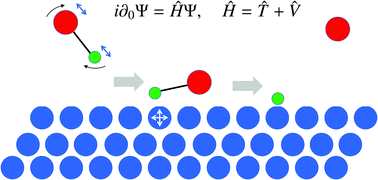Adiabatic models for the quantum dynamics of surface scattering with lattice effects
Abstract
In this contribution, we review models for the lattice effects in quantum dynamics calculations on surface scattering, which is important to modeling heterogeneous catalysis for achieving an interpretation of experimental measurements. Unlike dynamics models for reactions in the gas phase, those for heterogeneous reactions have to include the effects of the surface. For manageable computational costs in calculations, the effects of static surface (SS) are firstly modeled as this is simply and easily implemented. Then, the SS model has to be improved to include the effects of the flexible surface, that is the lattice effects. To do this, various surface models have been designed where the coordinates of the surface atoms are introduced in the Hamiltonian operator, especially those of the top surface atom. Based on this model Hamiltonian operator, extensive multi-dimension quantum dynamics calculations can be performed to recover the lattice effects. Here, we first review an overview of the techniques in constructing the Hamiltonian operator, which is a sum of the kinetic energy operator (KEO) and potential energy surface (PES). Since the PES containing the coordinates of the surface atoms in a cell is still expensive, the SS model is often accepted. We consider a mathematical model, called the coupled harmonic oscillator (CHO) model, to introduce the concepts of adiabatic and diabatic representations for separating the molecule and surface. Under the adiabatic model, we further introduce the expansion model where the potential function is Taylor expanded around the optimized geometry of the surface. By an expansion model truncated at the first and second order, various coupling surface models between the molecule and surface are derived. Moreover, by further and deeply understanding the adiabatic representation, an effective Hamiltonian operator is obtained by optimizing the total wave function in factorized form. By this factorized form of wave function and effective Hamiltonian operator, the geometry phase of the surface wave function is theoretically found. This theoretical prediction may be measured by carefully designing experiments. Finally, discussions on the adiabatic representation, the PES construction, and possibility of the classical-dynamics solutions are given. Based on these discussions, a simple outlook on the dynamics of photocatalytics is finally given.

- This article is part of the themed collection: PCCP Reviews


 Please wait while we load your content...
Please wait while we load your content...